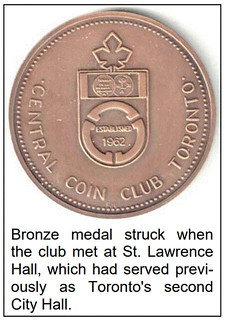
PREV ARTICLE
NEXT ARTICLE
FULL ISSUE
PREV FULL ISSUE
A NOT SO VALUABLE NUMISMATIC THEFTInspired by our discussion of noteworthy thefts of numismatic items, John Regitko of Toronto, Canada writes: "Some years ago when the Central Coin Club (Toronto) was in existence, I lost a few coins to thieves. I am attaching a write-up that was published in Canadian Coin News. It might not have been of great value, but they were "valuable" to me!" Thanks - here's the story! -Editor YMCA BREAK-IN YIELDS SILVER DOLLAR COLLECTION
As the club's liaison to the YMCA, I was asked to set up a display on coin collecting for a two-day showing of all the activities that take place at the "Y." I set up a two-case display of a set of Canadian silver dollars. The exhibits were not manned, so meeting details were incorporated into the display. While the displays were in the lobby, security was always present. Displays of some value, including my two cases, were locked up Saturday evening in the office on the second floor and brought out again on Sunday morning.
No cameras were present to capture the comings and goings in the building or individual offices in the 1960s. The Toronto Police CSI team dusted the window, lock and the display cases for fingerprints. They asked for my fingerprints so as to eliminate them as a suspect. As luck...or stupidity...would have it, a teenager bought some pop and candy at a local variety store a few blocks away, paying with silver dollars. The clerk thought it was unusual for a young kid to spend silver dollars and called the police who put two and two together. The police apprehended the teenager. The coins the clerk turned over to them, as well as a quantity of the others which the teenager still had on him, were returned to the YMCA who, in turn, gave them to me. I never found out the outcome of the charges against the young offender. However, since I was never called to testify, I assume the thief enjoyed the candy and pop he had purchased before being apprehended without penalty or restitution. After submitting a statement of claim to the YMCA's insurance company, I received a cheque which, to my best recollection, amounted to something just over $500, due to the condition of the coins and the fact insurance covered their full retail value. Since this took place around 1965, that would be over $3,700 in today's purchasing power. Cale B. Jarvis, the resident editor of Canada Coin News (which was founded by Chet Krause, publisher of Numismatic News of Iola, Wisconsin in 1963), did consulting work. He evaluated claims for insurance companies in cases of theft, fire, arson, flood, etc., of property and collectibles, including coins. He received my inventory of loss and my claim for replacement value from the insurance company and agreed with my evaluation. I found this out years later when he no longer represented insurance companies' interests. He stumbled upon his file copy years later and gave it to me. No 1948 silver dollar was returned, for a very good reason. The exhibit was directed towards members of the YMCA, not the numismatic community. Although reverses with the dates were shown for the most part. I also showed the obverses of George V, George VI and QE-II. Creativity of the layout enabled me to show the obverse of the 1948 dollar...except it was another year of George VI.
I sold it one year later for the going price of $150. If I had included it in the display and did not replace it because I had moved on to errors and primitive forms of money, I would probably have claimed $50 from the insurance company for its then retail value and would have lost out on a $100 profit. Mind you, if I had held onto it, today I could get thousands for it!
To read the earlier E-Sylum article, see:
Wayne Homren, Editor The Numismatic Bibliomania Society is a non-profit organization promoting numismatic literature. See our web site at coinbooks.org. To submit items for publication in The E-Sylum, write to the Editor at this address: whomren@gmail.com To subscribe go to: https://my.binhost.com/lists/listinfo/esylum All Rights Reserved. NBS Home Page Contact the NBS webmaster |



